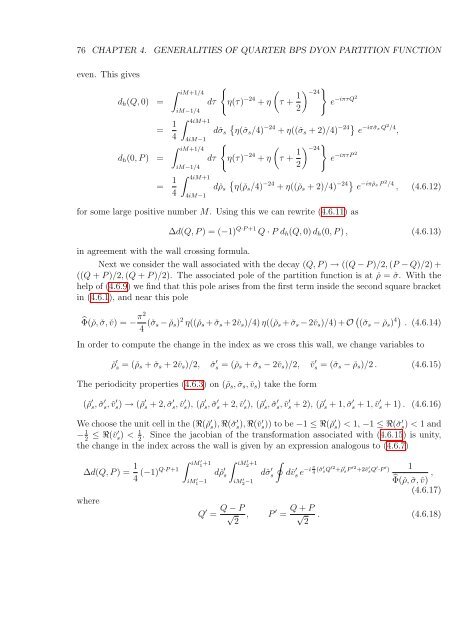PHYS08200604018 Shamik Banerjee - Homi Bhabha National ...
PHYS08200604018 Shamik Banerjee - Homi Bhabha National ...
PHYS08200604018 Shamik Banerjee - Homi Bhabha National ...
Create successful ePaper yourself
Turn your PDF publications into a flip-book with our unique Google optimized e-Paper software.
76 CHAPTER 4. GENERALITIES OF QUARTER BPS DYON PARTITION FUNCTION<br />
even. This gives<br />
d h (Q, 0) =<br />
d h (0, P ) =<br />
= 1 4<br />
= 1 4<br />
∫ iM+1/4<br />
iM−1/4<br />
∫ 4iM+1<br />
4iM−1<br />
∫ iM+1/4<br />
iM−1/4<br />
∫ 4iM+1<br />
4iM−1<br />
dτ<br />
dτ<br />
{<br />
η(τ) −24 + η<br />
(<br />
τ + 1 ) } −24<br />
e −iπτQ2<br />
2<br />
{<br />
dˇσ s η(ˇσs /4) −24 + η((ˇσ s + 2)/4) −24} e −iπˇσs Q2 /4 ,<br />
{<br />
(<br />
η(τ) −24 + η τ + 1 ) } −24<br />
e −iπτP 2<br />
2<br />
dˇρ s<br />
{<br />
η(ˇρs /4) −24 + η((ˇρ s + 2)/4) −24} e −iπ ˇρs P 2 /4 , (4.6.12)<br />
for some large positive number M. Using this we can rewrite (4.6.11) as<br />
in agreement with the wall crossing formula.<br />
∆d(Q, P ) = (−1) Q·P +1 Q · P d h (Q, 0) d h (0, P ) , (4.6.13)<br />
Next we consider the wall associated with the decay (Q, P ) → ((Q − P )/2, (P − Q)/2) +<br />
((Q + P )/2, (Q + P )/2). The associated pole of the partition function is at ˇρ = ˇσ. With the<br />
help of (4.6.9) we find that this pole arises from the first term inside the second square bracket<br />
in (4.6.1), and near this pole<br />
̂Φ(ˇρ, ˇσ, ˇv) = − π2<br />
4 (ˇσ s − ˇρ s ) 2 η((ˇρ s + ˇσ s + 2ˇv s )/4) η((ˇρ s + ˇσ s − 2ˇv s )/4) + O ( (ˇσ s − ˇρ s ) 4) . (4.6.14)<br />
In order to compute the change in the index as we cross this wall, we change variables to<br />
ˇρ ′ s = (ˇρ s + ˇσ s + 2ˇv s )/2, ˇσ ′ s = (ˇρ s + ˇσ s − 2ˇv s )/2, ˇv ′ s = (ˇσ s − ˇρ s )/2 . (4.6.15)<br />
The periodicity properties (4.6.3) on (ˇρ s , ˇσ s , ˇv s ) take the form<br />
(ˇρ ′ s, ˇσ ′ s, ˇv ′ s) → (ˇρ ′ s + 2, ˇσ ′ s, ˇv ′ s), (ˇρ ′ s, ˇσ ′ s + 2, ˇv ′ s), (ˇρ ′ s, ˇσ ′ s, ˇv ′ s + 2), (ˇρ ′ s + 1, ˇσ ′ s + 1, ˇv ′ s + 1) . (4.6.16)<br />
We choose the unit cell in the (R(ˇρ ′ s), R(ˇσ s), ′ R(ˇv s)) ′ to be −1 ≤ R(ˇρ ′ s) < 1, −1 ≤ R(ˇσ s) ′ < 1 and<br />
− 1 ≤ 2 R(ˇv′ s) < 1 . Since the jacobian of the transformation associated with (4.6.15) is unity,<br />
2<br />
the change in the index across the wall is given by an expression analogous to (4.6.7)<br />
∆d(Q, P ) = 1 ∫ iM ′ (−1)Q·P +1 1 +1<br />
dˇρ ′ s<br />
4<br />
where<br />
iM ′ 1 −1<br />
∫ iM ′<br />
2 +1<br />
iM ′ 2 −1<br />
dˇσ ′ s<br />
∮<br />
dˇv ′ s e −i π 4 (ˇσ′ sQ ′2 +ˇρ ′ sP ′2 +2ˇv ′ sQ ′·P ′ ) 1<br />
̂Φ(ˇρ, ˇσ, ˇv) ,<br />
(4.6.17)<br />
Q ′ = Q − P √<br />
2<br />
, P ′ = Q + P √<br />
2<br />
. (4.6.18)

















